| Feeding It is generally accepted that Dolichopodidae suck out contents of their prey (* see below). To my great astonishment I have found that Medetera never does so, but always swallows its prey (or releases it 'alive and kicking' if swallowing is impossible). At least 90% of Medetera's prey have to be called 'tiny creatures of unknown origin'. The feeding is difficult to observe because it appears only as follows: Medetera's hunting position is often finished by short and fast nod of the fly's head to the bark surface and then one can see during 1-2 sec slight movements of Medetera's horse-like lower part of face. That is all. To detect the origin of such prey one has to look at Medetera at hunting position through powerful macro lens. Figure 2 shows how little time has an observer even in case of Aphanogmus sp. which is not the smallest prey. (To forestall questions I do not know what the matter with fly's thorax is.) In a unique photo with really small prey, the prey is juvenile Collembola, probably Neanuridae - Neanura muscorum (fig. 3). I have a total of 52 observations with identified prey:
Prey marked red were afterwards released as too hard or too large (fig. 4). Bdeliid mites are a suitable size but were released, probably as poisonous, 2-4 sec after capture. | ||||||||||||||||||||||||||||||||
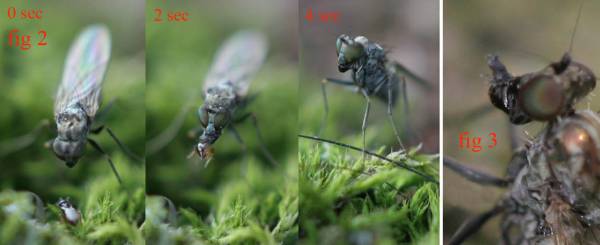 | ||||||||||||||||||||||||||||||||
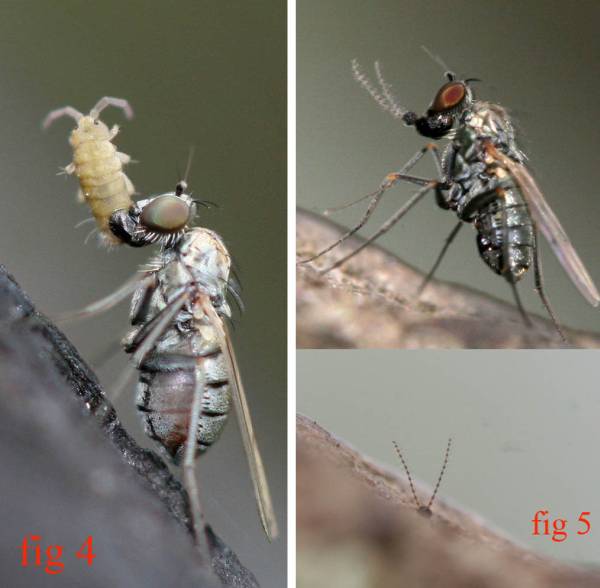 | ||||||||||||||||||||||||||||||||
Acarina (Macrochelidae), Collembola (Neanuridae), Hemiptera and Hymenoptera (Ceraphronidae) were swallowed in less than 5 sec. Medetera are very voracious; several times I observed two successful hunts of this kind during one minute. In case of large prey Medetera usually catches it by the dorsal side of the geometrical center of the prey's body and swallows the prey from hind part to head. The captured prey usually remains alive (moves legs and antennae and hold its body) for not more than 1 minute. Several times Medetera decapitated almost-swallowed Cecidomyiidae (fig. 5), or Sciaridae using its forelegs, and once broke off the furcula of an almost-swallowed Collembola, Isotomidae. Also with the help of its forelegs Medetera releases captured prey which it finds inedible for some reason. I have the impression, that Medetera cannot release prey by simply relaxing its mouthparts but can do it only with the use of its forelegs. Swallowing of aphids took 40-60 sec (fig. 6), but in one case 17 min. Swallowing of large Collembola took 3-10 min (fig. 7). Swallowing of Cecidomyiidae usually takes 4-5 min, but may be up to 15 min (fig. 8). It seems that Medetera's mouthparts work as an external elastic muscular stomach. I always observed fluid excrements of Medetera as shows fig. 7-5. Thus, it seems that Medetera completely digest prey. | ||||||||||||||||||||||||||||||||
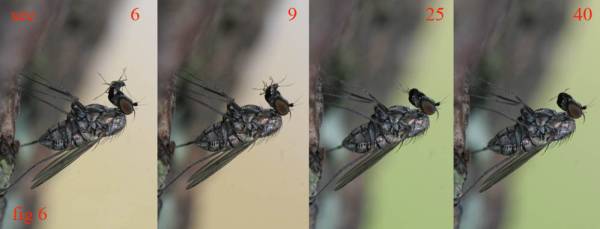 | ||||||||||||||||||||||||||||||||
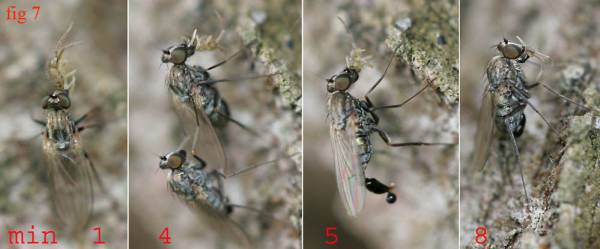 | ||||||||||||||||||||||||||||||||
 | ||||||||||||||||||||||||||||||||
I have never seen Medetera becoming prey for anything else. Only once I met Medetera with parasitic mite on its body (fig. 9). Medetera's detect its prey from a distance of 0.5 - 2 cm. Frequently I observed that Medetera detects Coccinellidae larvae or Cicadellidae from distance of 5-6 cm, runs to 2-3 cm and from this shorter distance realizes that the prey is too large and stops. So, Medetera has distant vision, but this vision is not keen enough. The hind quarter of Medetera's field of vision is a "blind sector". If, for example, an ant approaches to Medetera inside this blind sector, Medetera does not jump away, which is what it always does otherwise. This blind sector seems to be important also for courtship. | ||||||||||||||||||||||||||||||||
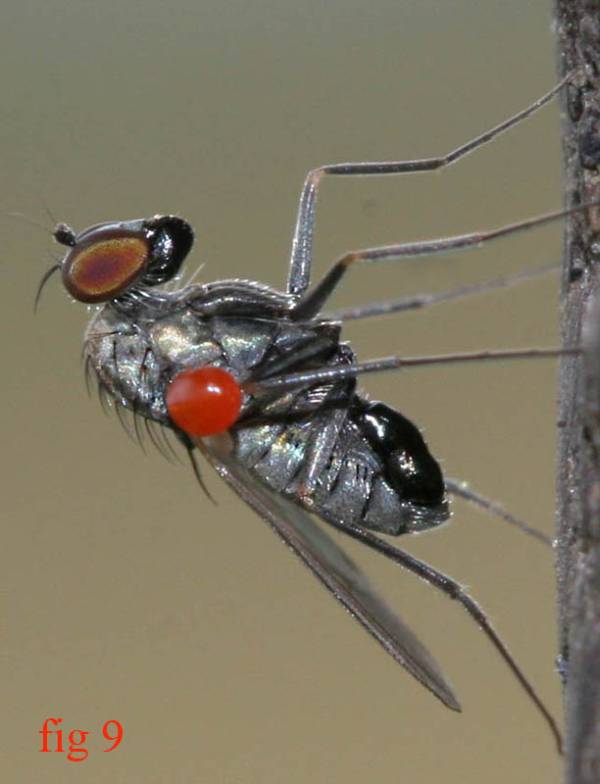 |
 |
||
|
||
 Users Online
Forum Threads
Newest Threads
· Unknown Stratiomyida...· Milichiidae?->Chloro... · Heleomyzidae ? · Ceratopogonidae (Ton... · Bibionidae: Bibio re... Hottest Threads
No Threads created
Theme Switcher
Last Seen Users
Latest Photo Additions
|
Observations on Medetera jacula (Fallén, 1823)
Comments
Post Comment
Please Login to Post a Comment.
Ratings
Rating is available to Members only.
Please login or register to vote.
| Date and time
Login
Temporary email?
Due to fact this site has functionality making use of your email address, any registration using a temporary email address will be rejected.
Paul Donate
Latest Articles
· Voltinism in Chaoborus
· Vitaliy Nikolaevich ... · Mating behaviour and... · Oviposition into the... · African Invertebrates Syrph the Net
License Agreement - Click to Download Public files of Syrph the Net can be downloaded HERE Last updated: 25.08.2011 Shoutbox
You must login to post a message. 17.08.23 15:23 Aneomochtherus
17.08.23 13:54 Tony, I HAD a blank in the file name. Sorry!
17.08.23 13:44 Tony, thanks! I tried it (see "Cylindromyia"
 but don't see the image in the post. but don't see the image in the post.17.08.23 11:37 pjt - just send the post and attached image. Do not preview thread, as this will lose the link to the image,
16.08.23 08:37 Tried to attach an image to a forum post. jpg, 32kB, 72dpi, no blanks, ... File name is correctly displayed, but when I click "Preview Thread" it just vanishes. Help!
23.02.23 21:29 Has anyone used the Leica DM500, any comments.
27.12.22 21:10 Thanks, Jan Willem! Much appreciated.
 19.12.22 11:33 Thanks Paul for your work on keeping this forum available!
Just made a donation via PayPal.
09.10.22 17:07 Yes, dipterologists from far abroad, please buy your copy at veldshop.
Stamps will be expensive, but he, the book is unreasonably cheap
 07.10.22 11:55 Can any1 help out with a pdf copy of
1941 Hammer. Vidensk. Meddel. Dansk Naturhist. Foren. 105;
thank you
|
|
images in Diptera Gallery and Forum of their respective owners Powered by PHP-Fusion copyright © 2002 - 2025 by Nick Jones. Released as free software without warranties under GNU Affero GPL v3. SimpleAsThat |
||
| Render time: 0.39 seconds | 200,285,764 unique visits | ||











behaviour.